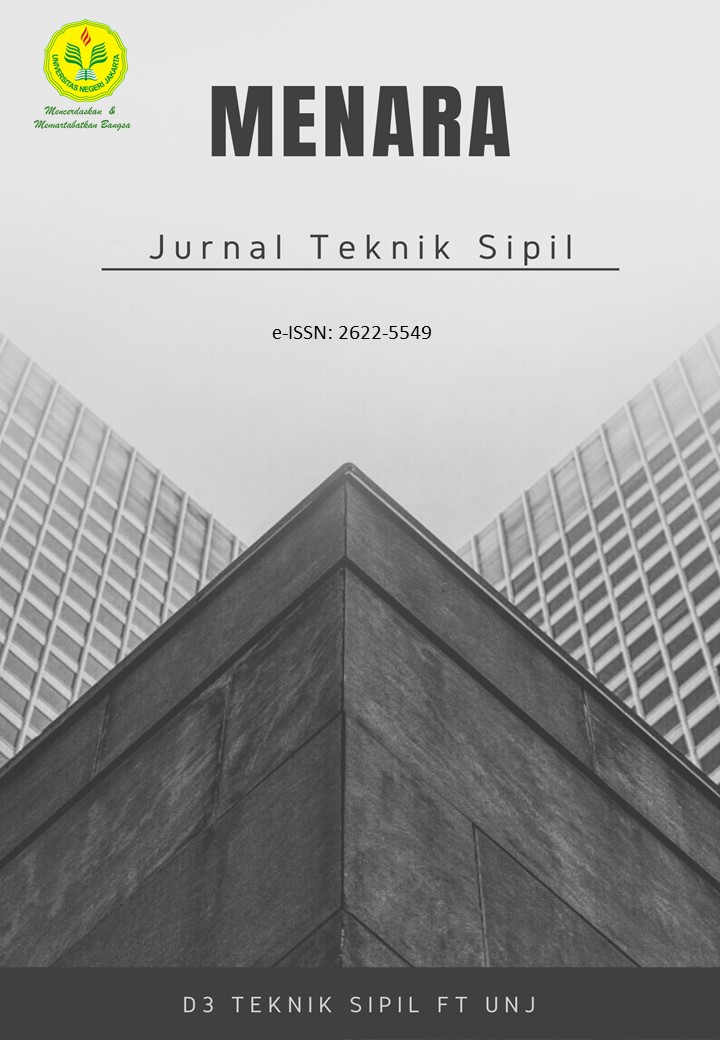Perencanaan Tebal Lapis Perkerasan Lentur Jalan Dengan Metode Bina Marga dan Analisa Komponen
Studi Kasus : Pelebaran Jalan Rainis – Melonguane – Beo – Esang, Kabupaten Kepulauan Talaud, Provinsi Sulawesi Utara
DOI:
https://doi.org/10.21009/jmenara.v13i2.17483Keywords:
Flexible Road Pavement, DGH Method, Component Analysis MethodAbstract
The highway is one of the most influential facilities in human life, both in social and economic terms. Therefore, if the quality of the highway is inadequate, then the economic level of the people who cross the road in the area. To create a quality road, it is necessary to plan with the appropriate method. Similarly, the Rainis-Melonguane - Beo- Esang Road segment in Talaud Islands District, North Sulawesi Province which widened the road from two ways with two lanes, into two ways with four lanes to improve the effectiveness of the local road usage. From the calculation result of thickness of pavement layer of bend road using DGH method and Component Analysis, it can be concluded that DGH method yields larger layer thickness with percentage difference of second layer thickness method on surface 68,75%, at base equal to 60%, And at sub-base 75,61%. Then, the thickness of the layer that can be used in this road widening project is the thickness of the layer calculated using the Component Analysis method because it has a thick layer of thin layer on the lowest CBR, but still qualifies the minimum thickness of the flexible pavement layer according to SKBI 2.3.26 1987.
References
Departemen Pekerjaan Umum. 1983. Petunjuk Pelaksanaan Lapis Aspal Beton Pondasi Atas (Laston Atas). Jakarta : Direktorat Jenderal Bina Marga.
Departemen Pekerjaan Umum. 1987. Petunjuk Perencanaan Tebal Perkerasan Lentur Jalan Raya dengan Metode Analisa Komponen SKBI-2.3.26.1987. Jakarta : Yayasan Badan Penerbit PU.
Departemen Pekerjaan Umum. 2007. Spesifikasi Umum Bidang Jalan dan Jembatan Divisi 6 Pekerjaan Aspal. Jakarta : Pusjatan – Puslitbang Pekerjaan Umum.
Kementrian Pekerjaan Umum Direktoran Jenderal Bina Marga. 2011. Pedoman Konstruksi dan Bangunan No. 002/P/BM/2011 Desain Perkerasan Jalan Lentur. Jakarta : Yayasan Badan Penerbit PU.
Wignall, Arthur. 1999. Proyek Jalan Teori dan Praktek. Jakarta : Penerbit Erlangga.
Oglesby, Clarkson. H. 1996. Teknik Jalan Raya Jilid II. Ed ke-4. Jakarta : Penerbit Erlangga.
Oglesby, Clarkson. H. 1999. Teknik Jalan Raya Jilid I. Ed ke-4. Jakarta : Penerbit Erlangga.
(Irwan, 2013; Mantiri, Sendow, & Manoppo, 2019; Murad & Novera, 2019; Nuryati, 2015; Sukirman, 1999)
Irwan, L. (2013). Studi Perbandingan Perkerasan Jalan Lentur Metode Bina Marga Dan Aastho Dengan Menggunakan Uji Dynamic Cone Penetration ( Ruas Jalan Bungku - Funuasingko Kabupaten Morowali ). Jurnal Transportasi.
Mantiri, C. C., Sendow, T. K., & Manoppo, M. R. . (2019). Analisa Tebal Perkerasan Lentur Jalan Baru Dengan Metode Bina Marga 2017 Dibandingkan Metode Aashto 1993. Jurnal Sipil Statik.
Murad, W., & Novera, M. (2019). Desain Perkerasan Lentur Berdasarkan Metode Bina Marga Ruas Jalan Simpang Seling – Muara Jernih Kabupaten Merangin. Jurnal Talenta Sipil. https://doi.org/10.33087/talentasipil.v2i1.14
Nuryati, S. (2015). ANALISIS TEBAL LAPIS PERKERASAN DENGAN METODE BINA MARGA 1987 DAN AASHTO 1986. Bentang.
Sukirman, S. (1999). Perkerasan Lentur Jalan Raya. Perkerasan Jalan Lentur.
Published
Issue
Section
License
Authors who publish with this Journal agree to the following terms:
- Author retain copyright and grant the journal right of first publication with the work simultaneously licensed under a creative commons attribution licensethat allow others to share the work within an acknowledgement of the work’s authorship and initial publication of this journal.
- Authors are able to enter into separate, additional contractual arrangementfor the non-exclusive distribution of the journal’s published version of the work (e.g. acknowledgement of its initial publication in this journal).
- Authors are permitted and encouraged to post their work online(e.g. in institutional repositories or on their websites) prior to and during the submission process, as it can lead to productive exchanges, as well as earlier and greater citation of published works.











